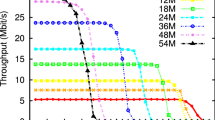Abstract
High data rate wireless technologies are now becoming a reality, and have spurred the development of new applications that were previously hindered by the lack of capacity. In particular, it is now possible to stream high definition movies from a laptop to a sound system and flat screen television seamlessly. One of the key enablers of such applications is the IEEE 802.15.3 medium access control (MAC) protocol, which is designed to support bandwidth intensive applications in wireless personal area networks (WPANs). A key observation is that a significant number of multi-media applications rely on the transmission control protocol (TCP). Unfortunately, little works have conducted a thorough performance study of TCP over the IEEE 802.15.3 MAC. Moreover, the IEEE 802.15.3 specification does not specify any strategies for allocating time slots. This paper therefore contributes to the current state-of-the-art in the following manners. From our extensive analytical and simulation studies, we reveal the impacts of different channel time allocation methods and acknowledgment policies on the performance of TCP, with particular attention on round trip time, congestion window growth, and packet recovery. We then present the following guidance to application developers: (1) channel time allocations (CTAs) should be distributed evenly over the superframe and have durations determined by TCP’s maximum congestion window, (2) CTA positioning has no impact on TCP’s performance, and (3) the specified delayed acknowledgment policy needs to be augmented with an adaptive algorithm that adjusts its burst size dynamically to varying bit error rate (BER).

















Similar content being viewed by others
Notes
Assuming that the sender has not asked for more than one CTA per superframe
This equation is not accurate if there are multiple timeouts, however given that the IEEE 802.15.3 MAC supports local retranmission we expect timeouts to be a rare event.
References
H. Chen, Z. Guo, R. Yao, and Y. Li, Adaptive dly-ack for TCP over 802.15.3 WPAN. In IEEE Globecom, Dallas, Texas, USA, 2004.
K.-W. Chin and D. Lowe, A simulation study of the IEEE 802.15.3 MAC protocol. In Australian Telecommunications and Network Applications Conference (ATNAC), Sydney, Australia, 2002.
D. A. Eckhardt and P. Steenkiste, Improving wireless LAN performace via adaptive local error control. IEEE ICNP, Austin, TX, USA, 1998.
J. Hong, I. Kim, D.-K. Bae, and H. Sung, Two-way CTA for TCP application, July 2004. IEEE P802.15 Working Group Document: IEEE 802.15-04/320-r0.
S.-Y. Hung, P.-Y. Chuang, Y.-H. Tseng, E. H.-K. Wu, and G.-H. Chen, Energy efficient TCP transmission for IEEE 802.15.3 WPAN. In 17th Annual IEEE Intl. Symposium on Personal, Indoor, and Mobile Radio Communications (PIMRC), Helsinki, Finland, Sept. 2006.
IEEE. 802.15 WPAN task group 3 (TG3). http://www.ieee802.org/15/pub/TG3.html .
IEEE 802.15.3 Working Group, Part 15.3: Wireless medium access control (MAC) and physical layer (PHY) specifications for high rate wireless personal area networks (WPAN). IEEE Draft Standard, Draft P802.15.3/D16, Feb. 2003.
IEEE 802.15.3 Working Group, DS-UWB physical layer submission to 802.15 task group 3a. IEEE Working Group Submission, July 2004.
V. Jacobson, R. Braden, and D. Borman, TCP extensions for high performance. RFC 1323, May 1992.
B. Lee, S. H. Rhee, Y.-A. Jeon, and S. Choi. TCP transfer mode for the IEEE 802.15.3 high rate wireless personal area networks. Lecture Notes in Computer Science, 3391/2005:912–922, Jan. 2005.
K.-H. Liu, H. Rutagemwa, X. Shen, and J. W. Mark, Efficiency and goodput analysis of dly-ack in IEEE 802.15.3. IEEE Transactions on Vehicular Technology, Vol. 56, No. 6, pp. 3888–3900, 2007.
M. Mathis, J. Semke, J. Mahdavi, and T. Ott, The macroscopic behavior of the TCP congestion avoidance algorithm. ACM SIGCOMM Computer Communication Review, Vol. 27, No. 3, pp. 67–82, 1997.
V. Paxson and M. Allman, Computing TCP’s retransmission timer. RFC 2988, Nov. 2000.
M. E. Schrader, Bi-directional CTA, July 2004. IEEE P802.15 Working Group Document: IEEE 802.15-04/382-r1.
B. Wang, J. Kurose, P. Shenoy, and D. Towsley, Multimedia streaming via TCP: an analytic performance study. ACM Multimedia, New York, USA, October, 1998.
Y. Xiao, X. Shen, and H. Jiang, Optimal ACK mechanisms of the IEEE 802.15.3 MAC for ultra-wideband systems. IEEE Journal on Selected Areas in Communications, Vol. 24, No. 4, pp. 836–845, 2006.
Author information
Authors and Affiliations
Corresponding author
Rights and permissions
About this article
Cite this article
Chin, KW., Lowe, D. TCP Over the IEEE 802.15.3 MAC: Analysis and Simulation. Int J Wireless Inf Networks 17, 73–88 (2010). https://doi.org/10.1007/s10776-010-0118-9
Received:
Accepted:
Published:
Issue Date:
DOI: https://doi.org/10.1007/s10776-010-0118-9




